The benefits of curiosity: how answering your child's endless questions will unlock their potential

It can be easy to feel overwhelmed by questions from your child, even though you know they must be making themselves ask for a reason. Understanding why questions are so brilliant for learning, and how best to answer them, can help make the stream of whats, whys and wheres feel a little more manageable.
As they discover more of the world around them, children become increasingly able to analyse and categorise the things they see and retain this information in their brain as learnt experiences.
This is often when they begin to ask more questions; they’re trying to make connections between new experiences and things they know in order to better understand what is happening around them.
This act of asking questions, and generally being curious, is believed to be an important part of cognitive development,[1] as children are seeking information which is highly relevant to a gap in their knowledge at a specific time – and research suggests the questions they ask are closely linked to the cognitive development they are experiencing, which is why the form and focus of questions can change over time.
As adults, being inquisitive and asking questions is an essential part of scientific thinking[2] and linked to creativity[3] too, so encouraging your child’s curiosity now can set the foundations for their future interest and understanding.
So, while this can prove a little repetitive to the ear of a parent, try and remind yourself of all the wonderful brain work that is going on behind the scenes and answer the questions when you can.
Here are some tips for answering questions in a way that will support your child’s developing cognitive skills:
- Listen closely to the question, but don’t guess an answer. If your child’s “Why?” could apply to multiple things, ask them to be more specific, perhaps ask, “Are you asking ‘Why is the sign red’ or ‘Why is the sign here?’”
- Try to answer with information that makes links for your child between the new or confusing thing, and something they already know. For example, you might be able to explain “The sign is red because it means ‘Stop Here’ – just like a red traffic light means stop."
- When children ask, “What’s that?” research[4] suggests they are more interested in what it does than simply knowing its name. By answering with a description of its function or role you might avoid lots of follow-up questions coming your way.
References:
[1] Chouinard M. M. (2007). ‘Children's questions: a mechanism for cognitive development’. Monographs of the Society for Research in Child Development, 72(1), vii–126. https://doi.org/10.1111/j.1540-5834.2007.00412.x
[2] Jirout J. J. (2020). ‘Supporting Early Scientific Thinking Through Curiosity’. Frontiers in psychology, 11, 1717. https://doi.org/10.3389/fpsyg.2020.01717
[3] Paine Hagtvedt, L., Dossinger, K., Harrison, S.H., Li Huang (2019) ‘Curiosity made the cat more creative: Specific curiosity as a driver of creativity’. Organizational Behavior and Human Decision Processes, 150:1-13, ISSN 0749-5978, https://doi.org/10.1016/j.obhdp.2018.10.007.
[4] Kemler Nelson, D. G., Egan, L. C., & Holt, M. B. (2004). ‘When children ask, "What is it?" what do they want to know about artifacts?’. Psychological science, 15(6), 384–389. https://doi.org/10.1111/j.0956-7976.2004.00689.x